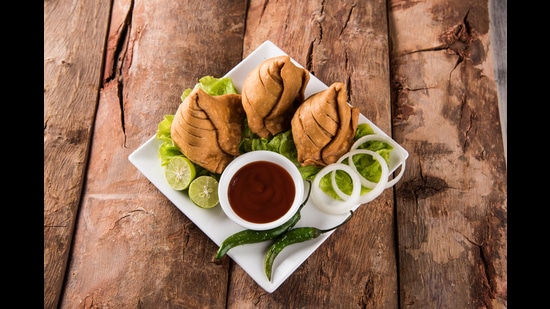
Snacking is a part of our daily little joys, a source of comfort and an integral facet of Indians’ love for food. With time and changing lifestyles, snacks have also evolved and become more experimental.
According to a report by market research firm IMARC Group, the Indian snacks market is projected to grow at a CAGR of 12% from 2022 to 2027. Contributing to this growth are food startups, introducing interesting flavours. Today, the market boasts a variety of snacks available in local flavours as well as adaptations influenced by the West. And, fried snacks hold a significant position in the market. “Fried snacks are mainly known for their crispness and saltiness. Irrespective of age groups, they satisfy every palate. Due to the texture and saltiness, they tend to be addictive. For instance, French fries or potato wedges are loved by all,” says chef Ajay Chopra.
The snacks saga
So, what’s considered a snack? They are smaller portions of food that we generally indulge in between meals. “It could be anything — from cookies, chips and namkeens to samosas, tikki and chaats,” says Shikhar Veer Singh, founder and culinary expert, Samosa Singh.
India, a land of diversity, witnesses amazing variety even in the snacks segment. Migration and assimilation of communities led to snacks from various cuisines being introduced on our plates. For instance, samosa is believed to have originated in the Middle East as a non-vegetarian snack made with minced meat. However, in India, it is relished with a potato and pea filling.
Every part of India offers its own specialties. “It depends on the available ingredients, season and geographical conditions of the region,” shares Chopra, listing some of the widely known Indian snacks — vegetable chop, nimki and churmur from the east, vada pav and vanela gathiya from the west, samosa and kachori from the north and goli baje and masala vada from the south.
Healthy snacks? why not!
Snacks need not necessarily be a no-go zone for fitness enthusiasts. From sev, chivda, bhujia, chips and masala nuts, one can find options in healthy versions, too. “Given that since the pandemic, there has been an increased focus on nutrition, the healthy snack category is expected to cross $150 billion globally by 2030,” notes Shauravi Malik, co-founder of Slurrp Farm, which offers a diverse range of snacks and food items with nutrient-dense ingredients. Healthy snacks are typically made of ragi, jowar, oats, foxtail millet, lentils, amaranth, nuts, and natural sweeteners like jaggery and honey.
A dose of nutrition for homemade snacks
If you want to amp up the health quotient of snacks at home, here are some tips from Reetu Uday Kugaji, culinary expert who often shares recipes on her Facebook page, Food For Thought: “Instead of deep frying, opt for shallow frying, air frying, baking, grilling or steaming. Replace table salt with kosher salt. Use local, organic and seasonal fruits and veggies in snack preparations. Try these tips the next time you make Maharashtrian savoury kothimbir vadi, Gujarati panki, chegodilu, a fried snack from Andhra Pradesh, or hurigaalu, a protein-packed mixed lentil snack from Karnataka.”
Unique flavours
Be it the traditional besan bhujia made more fun with chilli and cheese, puffed rice and besan namkeen with a kairi zing or corn chivda with peri peri seasoning, chefs are giving existing combinations a unique twist. “In our Khasta Kachori, we combine kachoris and bhakarwadi. Chilli Cheese Bhujia is a scrumptious combination of chilli and cheese. There are endless possibilities with fusion snacks,” says Girish Nayak, chef from Bombay Sweet Shop.
Tips for people who would like to make snacks at home?
- The quality of oil you use in making snacks at home plays a very important role! Ise coconut or groundnut oil, it adds to the flavour and these oils are healthier alternatives to add into your daily diet
- Always remember that it’s best to add spices and seasoning while the mixture is hot. It’s harder for it to come together after it cools down
- Keep in mind that it takes atleast a day for all the flavours to come out, taste and adjust spices and seasoning only on the next day and not the same day
By Girish Nayak

RECIPE
Vada Pav Spring Role Recipe-
Ingredients:
Curry leaves 10 grams
Garlic chopped 20 grams
Mustard seeds 3 grams
Boiled potato 200 grams
Salt to taste
Turmeric 5 grams
Pav 2 nos
Spring roll sheet 2nos
For Dry Vada pav chutney:
Red chilli powder 20 grams
Garlic 20 grams
Coconut dry 10 grams
Heeng 5 grams
Coriander seeds 10 grams
Cumin seeds 5 grams
Curry leaves 10 grams
Green chutney:
Green chilly 10 grams
Coriander green 30 grams
Garlic 10 grams
Salt to taste
Method:
Take a pav and open it half.
Place it on a spring roll sheet (available in food stores).
Then add the masala(mixture) that we prepared using the ingredients on the pav.
Put some Vada pav chutney (dry chutney) over the masala.
Now gently roll the pav and the spring roll sheet to form a cylinder.
Put some edible gum (made with cornflower slurry) so that the spring roll sheets don’t
open up and are tightly packed.
Now in some hot oil, deep fry the Vada pav spring rolls until it gets crispy and golden
brown.
Add some whole green chilies to quickly fry them in the side for some spicy bites.
Remove the spring roll and serve it hot.
By Ajay Chopra, Chef
Personalise your news feed. Follow trending topics
Snack attack! treats for tastebuds - Hindustan Times
Read More


No comments:
Post a Comment